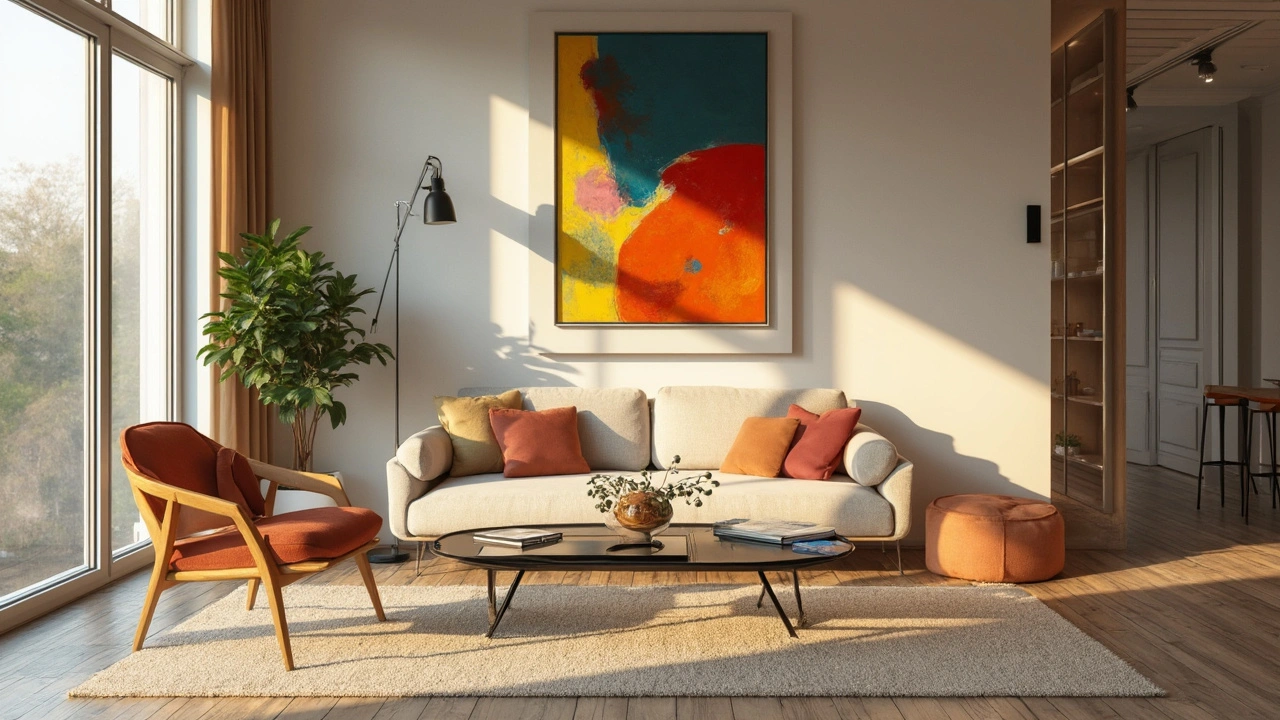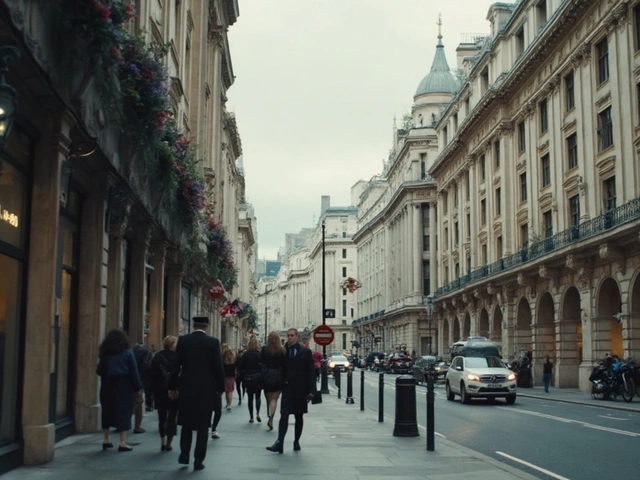The Bauhaus movement didn't just ruffle feathers; it reinvented the entire flock. Born out of a desire to harmonize art and industrial design, this school of thought took simplistic functionality and turned it into an art form that resonated through years and across continents. Gone were the ornate scrolls and lavish decorations, replaced by clean lines and practical designs that were as beautiful as they were functional.
Perfectly balancing form with function, Bauhaus was ahead of its time, setting the stage for a design philosophy that still influences contemporary aesthetics. This wasn't just about making furniture or buildings; it was about crafting a new way of interaction between humans and their habitat. If you've ever picked up an item that seemed to be both intuitively designed and charmingly simple, you've experienced the ghost of Bauhaus whispering through history.
- Origins of Bauhaus Style
- Key Philosophies and Influences
- Impact on Modern Design
- Bauhaus in Everyday Life
Origins of Bauhaus Style
The dawn of the Bauhaus style marks a fascinating chapter in design history, emerging from the ashes of post-World War I Germany. Founded in 1919 by architect Walter Gropius in Weimar, the Staatliches Bauhaus art school sought to unify art, craft, and technology in the creation of practical yet aesthetically pleasing objects. Gropius envisioned a radical new approach to design that blurred the lines between form and function, pushing back against the opulence of pre-war design traditions.
Revolutionary Beginnings
At its core, the Bauhaus movement was a response to the changing landscape of the industrial age. The world had just witnessed the devastation of war, and the Bauhaus sought to redefine art’s role in society, making it more accessible to the masses—a stark departure from the elitist nature of art and design that preceded it. This philosophy was epitomized in their manifesto which insisted on the unity of arts and craftsmanship.
Key Influencers and Faculty
The school attracted an eclectic mix of avant-garde artists and designers who became key influencers in shaping its ideology. Notable figures included Wassily Kandinsky, Paul Klee, and Marcel Breuer, whose diverse backgrounds enriched the curriculum with a wide range of perspectives. These luminaries stressed experimentation and innovation, encouraging students to engage in interdisciplinary learning—a hallmark of the Bauhaus style.
Transition and Challenges
Despite its revolutionary approach, the Bauhaus faced its share of challenges. Political pressure and financial constraints forced the school to relocate twice, moving from Weimar to Dessau in 1925, and later to Berlin in 1932, before its eventual closure in 1933 by the Nazi regime, which opposed its modernist ideals. Yet, this forced diaspora allowed Bauhaus principles to spread internationally, particularly influencing architecture in cities like Tel Aviv, known as the 'White City' for its collection of over 4,000 Bauhaus buildings.
In essence, the origins of the Bauhaus style are deeply intertwined with the socio-economic upheavals of its time, yet its legacy endures, serving as a testament to the unbridled creativity and forward-thinking that define modern design.
Key Philosophies and Influences
At the heart of the Bauhaus movement lies a revolutionary philosophy: an unwavering commitment to unifying art, craft, and technology. This progressive idea was championed by its founder, Walter Gropius, who believed that both artists and craftsmen should play a crucial role in an industrialized society. This integrated approach encouraged collaboration across disciplines, breaking down the traditional boundaries between the fine and applied arts.
Bauhaus was heavily influenced by the German concept of Gesamtkunstwerk—which translates to "total work of art." This comprehensive approach sought to synthesize various art forms, unifying them into a singular artistic expression. Guided by this principle, the Bauhaus ethos emphasized that every creative decision, from architecture to ceramics, should contribute to an overarching vision of harmonious design.
Form Follows Function
One of the most influential maxims of the Bauhaus was "form follows function." This philosophy advocated for designs that are inherently functional rather than adorned with superfluous elements. The use of geometric shapes, innovative materials, and clean lines became the movement’s signature, eschewing ornate detailing in favor of utility and elegance. This principle resonated across modernism and still serves as a bedrock for countless architects and designers today.
Industrial Techniques and Mass Production
The Bauhaus embraced the potential of modern industrial techniques, aspiring to democratize high-quality design for the masses. By integrating art with industrial production, Bauhaus prioritized creating designs that could be manufactured on a large scale without compromising on aesthetic value. This visionary approach united form and process, championing an era where design was accessible, affordable, and impactful.
The incorporation of new materials like tubular steel and concrete into conventional aesthetics reflected the ingenuity of Bauhaus architects, spawning a range of minimalist yet stunningly impactful creations—from furniture pieces to architecture.
Lasting Influence
Though the original Bauhaus school existed for a mere 14 years before political pressure forced its closure, its principles have persisted through subsequent generations. Modern-day galleries, furniture showrooms, and cityscapes show a clear lineage back to Bauhaus ideals, proving that this innovative design philosophy continues to influence the way we live, work, and create.
This transition from isolated practices to a cohesive vision of art and technology continues to vigorate the contemporary world, affirming the Bauhaus as more than just a historical movement, but a continuous force in architecture and design.

Impact on Modern Design
Bauhaus, a movement synonymous with innovation and minimalism, has had a monumental impact on modern design. Its influence stretches across various fields, from architecture to graphic design, and its principles remain a guiding light for contemporary creators. The focus on combining functionality with exceptional aesthetic appeal reshaped how design was perceived and practiced.
A foundational tenet of Bauhaus is the unity of art, craft, and technology. This approach didn't just change design methods; it fostered a paradigm shift where designers began to view their work as an interplay of varied disciplines. Consider the now-iconic Barcelona Chair, designed by Ludwig Mies van der Rohe and Lilly Reich during the Bauhaus era. Its sleek lines and use of modern materials like chrome and leather continue to inspire furniture designers worldwide.
Architecture and Urban Planning
The Bauhaus style, renowned for its 'form follows function' doctrine, heavily influenced architectural design. Modernism owes much of its clean lines and open spaces to this philosophy. Buildings that embraced this style, like Walter Gropius's Bauhaus Building in Dessau, exhibited economy of design and spatial efficiency that are staples in contemporary architecture. This aesthetic has been particularly pivotal in the evolution of urban public spaces that aim to maximize utility and simplicity.
"The ultimate aim of all creative activity is a building! The decoration of a building was once the noblest function of the fine arts, and the fine arts were indispensable to great architecture." - Walter Gropius
Graphic Design and Branding
Bauhaus wasn't confined to physical structures and furniture; it played a crucial role in revolutionizing graphic design. The use of sans-serif typography, geometric shapes, and asymmetrical layouts—hallmarks of Bauhaus graphics—has paved the way for today's digital design aesthetics. It's fascinating to note how corporate branding, such as that of Google, Apple, and countless tech start-ups, often reflects Bauhaus ideals of simplicity and clarity.
Everyday Objects and Consumer Products
The Bauhaus's functionalist ethos extended to everyday objects, influencing the design of items from household goods to electronics. The minimalist and utilitarian design language of Bauhaus can be seen today in products like the iPhone, blending form with utility seamlessly.
As testament to its enduring influence, many modern designers still draw inspiration from Bauhaus principles, pushing the boundaries of what design can achieve in everyday life.
| Domain | Focus | Example |
|---|---|---|
| Architecture | Open Space, Simplicity | Bauhaus Dessau |
| Furniture Design | Functionality, Modern Materials | Barcelona Chair |
| Graphic Design | Minimalism, Clarity | Google's Logo |
Bauhaus in Everyday Life
The influence of Bauhaus transcends time, reaching into modern design paradigms and everyday objects that many of us might not associate with its revolutionary roots. The iconic principles of this movement - form following function - can be seen everywhere, from the minimalist aesthetics of today's sleek technology to the simple elegance of home furnishings.
The Modern Home
Take a look around any modern home; you'll likely find elements reflective of Bauhaus ethos. The clean, geometric lines of a sofa, the subdued color palette of interior walls, or even a smart thermostat's intuitive design can trace their lineage back to the teachings of Bauhaus. The open-plan concept, now a staple in contemporary architecture, also finds its origins in Bauhaus, favoring functionality and unencumbered space.
Furniture: A Symphony of Simplicity
In the world of furniture design, Bauhaus's impact is profound. Consider the Marcel Breuer’s Wassily Chair, a piece still revered today for its innovative use of materials and form. This chair, created with tubular steel and stark leather, exemplifies the movement's commitment to simplicity and industrial design.
Bauhaus in Technology
The influence doesn't stop at furniture. With technology, Bauhaus principles shine in the intuitiveness and straightforward design strategies employed by major tech companies. Apple's design language, championed by Jony Ive, is a direct nod to the Bauhaus philosophy—combining simple, elegant forms with highly functional applications.
Urban Spaces and Environment
Beyond individual objects, even urban spaces bear the mark of Bauhaus thought. Many of the principles that guided Walter Gropius and his followers have inspired urban planners to create cities that prioritize human scale and interaction with the environment. Today's eco-friendly urban developments, with their focus on functionality, accessibility, and minimal environmental impact, echo Bauhaus teachings.
Fashion: Beyond the Canvas
In fashion, the minimalist aesthetic that Bauhaus celebrated is alive and thriving. Designers like Mies Van der Rohe and László Moholy-Nagy ventured into textile design, bringing a functional yet striking simplicity to their work. This legacy persists in contemporary fashion with the emphasis on utilitarian and asymmetric styles.
| Element | Bauhaus Impact |
|---|---|
| Home Interiors | Open-plan spaces, minimalist aesthetic |
| Furniture | Function-driven, geometric designs like the Wassily Chair |
| Technology | Simple interfaces, functional design |
| Urban Planning | Sustainable design, human-centered architecture |
| Fashion | Minimalist and functional design |
By fusing art with industry, Bauhaus reshaped understanding in not just the aesthetic but also in how we engage with daily life. From our bustling cities to the intimate corners of our homes, the movement's contributions are all around us, encouraging a lifestyle where design is not just seen but felt in every interaction and enhancement of our surroundings.





